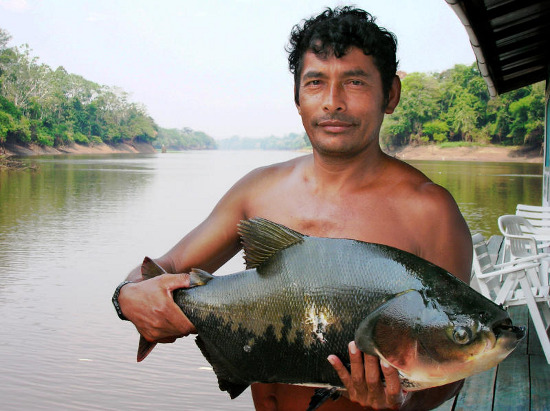Amazon's freshwater ecosystem is sensitive to environmental degradation
A new study published in Conservation Letters this week said freshwater ecosystems in the Amazon region are very sensitive to environmental degradation.
River, lake and wetland ecosystems - covering about one fifth of the Amazon basin - are increasingly degraded by deforestation, pollution, construction of dams and waterways as well as love. overexploitation of animal and plant species.
The study was led by Dr. Leandro Castello, a collaborative researcher at Woods Hole Research Center (WHRC), in collaboration with scientists from various organizations in the United States and Brazil. Organizations include the Amazon Environmental Research Institute (IPAM), the University of California at Santa Barbara (UCSB), the Brazilian Space Research Institute (INPE), and the Nature Conservancy (TNC).
The threat to the Amazon freshwater ecosystem has a great impact on Amazon residents, the historic inhabitants are too dependent on the products and services of the freshwater ecosystem they are called 'country people'.
Current Brazilian per capita consumption of fish in the Amazon region along the river is about 94kg / year on average, nearly six times higher than the world average. Increasing fishing pressure has narrowed the size of captured species, in part due to the decline in large, high-value species. A century ago, the maximum length means that the body of the main species caught in the basin is about ~ 206cm - today it is only ~ 79cm long.

The science and policies in Amazon have focused primarily on forests and the relevance of forests to forest biodiversity and carbon storage. Three decades of effort has created an understanding of some important physiological transitions in the basin, and the establishment of a network of protected areas, primarily designed to protect forests and diversity. Biological form of forest. Little attention has been paid to the freshwater ecosystems that these ecosystems have through hydrological cycles, connected to other ecosystems in other remote areas and areas, which are very sensitive. with a variety of human effects.
Robin Abell, a biologist at the World Wildlife Fund, commented: "Despite some very high global standards for protecting terrestrial ecosystems, this article shows important vulnerabilities in protection of Amazon's ecosystems and freshwater species ". For example, the Madeira River basin is threatened by oil and gas exploitation, deforestation and its upstream dams, although the protected area covers 26% of the catchment area.
"The pressures that the authors detail need to be addressed now, before the conservation opportunity is lost," Abell warned, the cost of recovery may be much more expensive than protecting the owner. dynamic.
The main threats to most Amazon freshwater ecosystems are the large-scale transformation of the basin's natural hydrological regime.
"There are a total of 154 hydroelectric dams in operation, 21 dams are under construction, and other 277 dams will be built in the future. There are also thousands of small dams on small streams to provide water supply for cattle, " said WHRC co-author Marcia Macedo.
"Infrastructure projects along with deforestation have caused changes in rainfall in the region, which can fundamentally change the hydrological regime of Amazon's river systems , " she added. . Research shows that if left unchecked, such hydrological changes could disrupt fish migration and lead to a reduction in fisheries production, threatening riparian livelihoods and food security.
Adequate protection of Amazon freshwater ecosystems requires the expansion of forest centers focusing on current environmental management and conservation strategies including aquatic ecosystems. By building on existing protected areas, a conservation dike based on river water can be developed to protect both aquatic and terrestrial ecosystems, effectively protect the forest system - Amazon river.
The Amazon basin extends over six countries, Brazil, Bolivia, and Peru are the three countries that occupy most of the basin area. Therefore, "This basin approach is very critical, in terms of national conservation and management efforts," said co-author Dr. Laura Hess of the UCSB Earth Research Institute.
"Everywhere there are environmental problems, but in the case of Amazon's freshwater ecosystems it is different, because no one talks about it. Its problems have been hidden," Castello said. Emphasizing the need for a change, he added, "Significant advances in Amazon conservation have been achieved in combating deforestation because deforestation has been studied and monitored annually." . Now we need to do that for these aquatic ecosystems. "
- Freshwater in Europe is polluted worse than estimated
- Singapore inaugurated the first water park
- China promotes recycling of industrial waste
- Impressive image of Earth Day
- Pollution in China is at an alarming rate
- Establish new protected areas to protect rare dolphins
- Discovered a giant freshwater lake located underground, up to 2,800 km3 in volume
- Securing the coral reef ecosystem in Phu Quoc
- Chinese desert freshwater lake gradually disappears
- Nearly $ 500 billion
- Biodiversity: A balance between conservation and exploitation is needed
- Mekong sub-region focuses on green growth
 Is the magnetic North Pole shift dangerous to humanity?
Is the magnetic North Pole shift dangerous to humanity? Washington legalizes the recycling of human bodies into fertilizer
Washington legalizes the recycling of human bodies into fertilizer Lightning stone - the mysterious guest
Lightning stone - the mysterious guest Stunned by the mysterious sunset, strange appearance
Stunned by the mysterious sunset, strange appearance